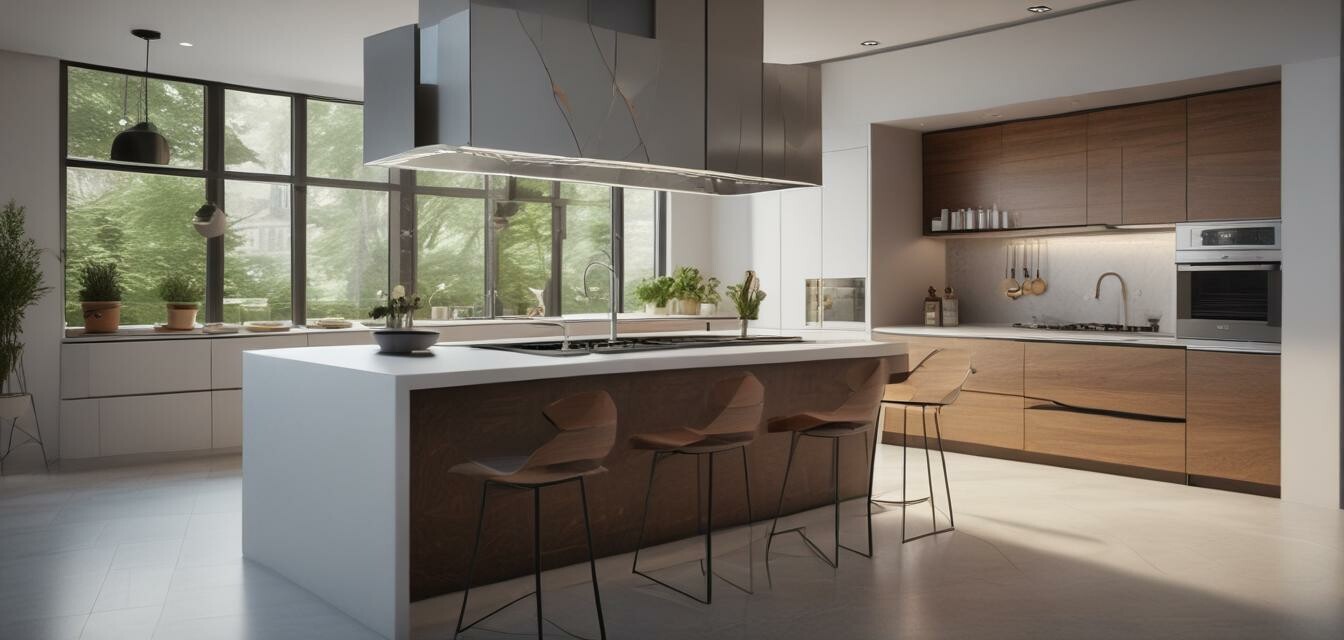
Trends shaping the future of smart kitchen design
The kitchen is evolving rapidly, with advances in technology transforming how we cook, clean, and organize our culinary spaces. In 2025, smart kitchen design will blend functionality with stylish aesthetics, promoting efficiency and convenience. This article explores the key trends shaping the future of smart kitchen design.
Key Takeaways
- Integration of smart appliances for enhanced cooking experiences.
- Focus on sustainability and eco-friendly materials.
- Enhanced connectivity with IoT devices for seamless control.
- Flexible layouts that adapt to user needs.
- Emphasis on aesthetics and personalization in design.
1. Integration of smart appliances
The demand for smart appliances continues to rise, encapsulating features such as touchless faucets, intelligent cooktops, and smart ovens. These devices not only make cooking easier but also allow for greater control over kitchen tasks.
Smart appliances communicate with each other, creating an integrated ecosystem for cooking, cleaning, and food storage. The convenience of managing multiple appliances from your smartphone or voice-activated assistants is becoming increasingly popular.
Benefits of Smart Appliances
- Time-saving functionalities
- Energy efficiency
- Real-time monitoring and notifications
2. Focus on sustainability
As society shifts towards more environmentally conscious choices, sustainable kitchen design will become increasingly vital. From energy-efficient appliances to eco-friendly materials, the smart kitchen of the future will highlight a commitment to reducing our carbon footprint.
Innovative materials such as recycled plastics and sustainably sourced woods are gaining popularity, leading to kitchens that are both beautiful and responsible. Furthermore, smart technologies will enable users to monitor energy consumption, ensuring kitchens operate as efficiently as possible.
Eco-friendly features to look out for
| Feature | Description |
|---|---|
| Energy-efficient appliances | Products that consume less energy while providing optimal performance. |
| Water-saving faucets | Devices designed to minimize water usage without sacrificing performance. |
| Compost systems | Smart solutions for managing food waste sustainably. |
3. Enhanced connectivity
The Internet of Things (IoT) is facilitating greater connectivity in kitchen environments. Smart kitchen designs will incorporate devices that can communicate and be controlled remotely, enhancing user experience. For example, users can preheat their ovens, adjust lighting, or even receive alerts when groceries are running low, all from their smartphones.
This connectivity is not just about convenience; it also promotes safety, as connected devices can share information about fire hazards, carbon monoxide levels, and other potential dangers.
Examples of connected devices
- Smart refrigerators
- Bluetooth-enabled appliances
- Touchless faucets with sensors
4. Flexible layouts
The future of kitchen design is all about flexibility. Homeowners are looking for modular solutions that can adapt to their evolving needs. This trend is particularly evident in open-concept spaces, where kitchens serve as both functional workspaces and social areas.
From movable islands to expandable countertops, flexibility in design promotes greater functionality tailored to individual preferences and lifestyle habits.
Popular layout designs
- Open-concept kitchens
- Galley kitchens with movable islands
- Multi-functional spaces combining cooking and dining areas
5. Aesthetics and personalization
Kitchens are no longer just cooking spaces; they have become the heart of the home. Personalized designs, integrating style with functionality, play a crucial role in smart kitchen trends. Homeowners are favoring unique finishes, colors, and hardware that reflect their personal tastes while incorporating advanced technology.
Moreover, the use of smart lighting that adjusts to activities or mood enhances the kitchen environment, making it more inviting and functional.
Trendy design elements
| Element | Trend | Benefits |
|---|---|---|
| Smart Lighting | LEDs with adjustable color temperature | Enhances mood and workspace efficiency |
| Modern finishes | Matte black fixtures and mixed metals | Creates a contemporary look |
| Open shelving | Transparent displays of cookware and dishes | Encourages a sense of openness and accessibility |
Tips for designing your smart kitchen
- Evaluate your cooking habits and needs.
- Select appliances that integrate seamlessly with your design vision.
- Consider the flow of traffic and how people will use the space.
- Incorporate smart lighting for both functionality and ambiance.
- Stay informed on the latest technology advancements and trends.
Pros
- Enhanced cooking efficiency.
- Improved convenience and user control.
- Environmentally friendly options available.
Cons
- Higher initial investment costs.
- Some technologies require a learning curve.
Conclusion
The trends in smart kitchen design are rapidly evolving, emphasizing efficiency, sustainability, and personalization. As technology progresses, homeowners can expect kitchens that not only serve as cooking spaces but also as versatile and aesthetically pleasing environments. To learn more about smart kitchen appliances and how to enhance your kitchen, visit our Smart Kitchen Buying Guides.